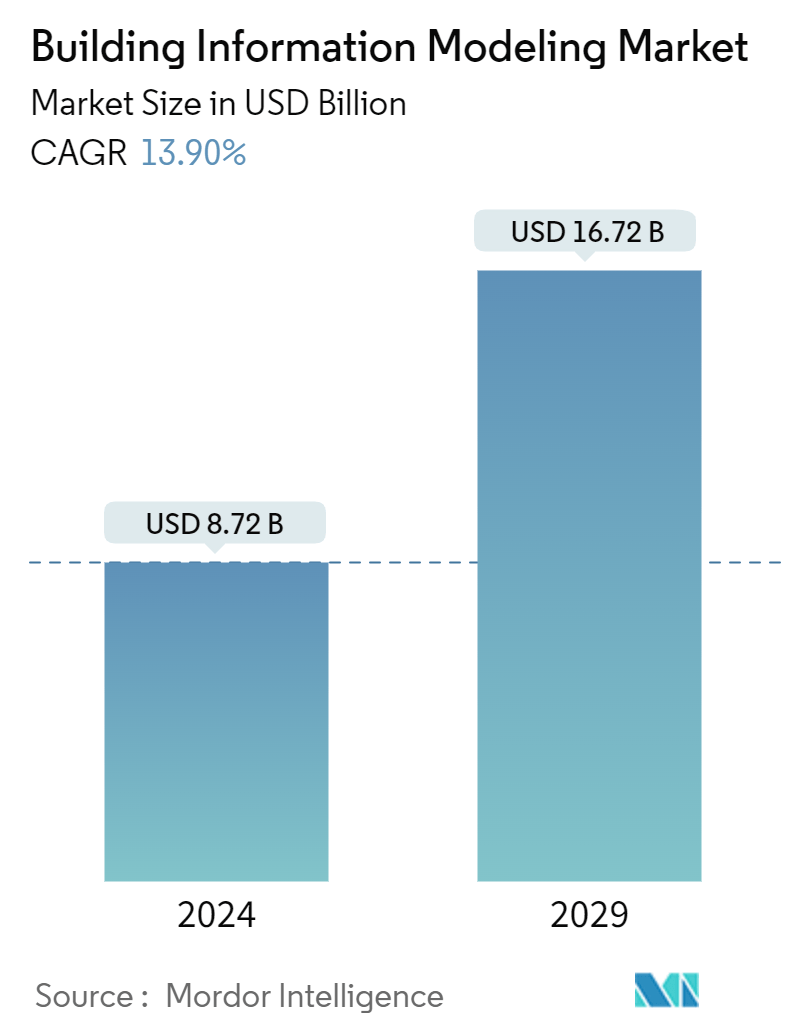Market Size of Building Information Modeling Industry

| Study Period | 2019 - 2029 |
| Market Size (2024) | USD 8.72 Billion |
| Market Size (2029) | USD 16.72 Billion |
| CAGR (2024 - 2029) | 13.90 % |
| Fastest Growing Market | Asia Pacific |
| Largest Market | North America |
Major Players
*Disclaimer: Major Players sorted in no particular order |
Building Information Modeling (BIM) Market Analysis
The Building Information Modeling Market size is estimated at USD 8.72 billion in 2024, and is expected to reach USD 16.72 billion by 2029, growing at a CAGR of 13.90% during the forecast period (2024-2029).
Building Information Modeling (BIM) is a crucial digital representation process that supports the planning, design, and management of construction projects across various sectors. BIM has significantly reshaped the architecture, engineering, and construction (AEC) industries by enabling enhanced collaboration and improved project outcomes. As the construction industry continues to embrace digital transformation, the adoption of BIM software has seen considerable growth. This adoption aligns with the industry's broader objectives to boost efficiency, reduce costs, and accelerate project timelines. The market landscape for BIM encompasses diverse software and service-based solutions designed for applications ranging from commercial to residential construction.
BIM has grown in relevance as a collaborative tool for contractors, architects, and facilities managers. The integration of advanced technologies, such as cloud computing, AI-driven analytics, and digital twin technology, has further expanded its capabilities. These technologies allow for real-time updates and enhanced oversight of complex infrastructure projects, ensuring precision during construction and enabling better long-term facility management.
The global BIM market is evolving, spurred by a combination of regulatory frameworks and private sector initiatives designed to improve project efficiency. Although BIM has been shown to streamline workflows and increase productivity, challenges such as high software costs and complexity in training have slowed its adoption, particularly among small and medium-sized enterprises (SMEs).
Governmental Mandates and International Standards Encouraging BIM Adoption
- BIM mandates driving adoption in key markets: Government regulations play a pivotal role in the global adoption of BIM technology, especially in regions like Europe and North America. Many countries, including the United Kingdom, Germany, and Singapore, have implemented BIM mandates for public infrastructure projects, underscoring its importance in achieving greater project transparency and efficiency.
- International standards fostering interoperability: BIM standards like ISO 19650, which provides a framework for the management of information using BIM, have been instrumental in ensuring data consistency and reliability. These standards promote smoother data exchanges between project teams, reducing project risks and fostering greater interoperability across various platforms.
- Asia-Pacific's push toward BIM: In the Asia-Pacific region, countries like China and Japan have integrated BIM into national construction policies, especially for large-scale infrastructure projects. Governments in these regions recognize the long-term cost savings derived from BIM’s improved planning and data accuracy, further promoting its adoption.
- Government mandates boost market growth: As sustainability and efficiency in construction gain importance, governmental pushes for BIM adoption are expected to drive further market expansion. These mandates will continue to shape adoption patterns in key markets worldwide, contributing to the global BIM market growth.
Boosting Project Performance and Productivity
- Enhanced project efficiency through BIM: BIM has proven to be invaluable in improving project performance, particularly in large-scale construction projects. The technology enables the creation of highly detailed 3D models, allowing teams to identify potential issues early in the planning stage and coordinate efforts before construction begins. This leads to fewer design errors and costly change orders.
- Shortened project timelines: By simulating various project stages within a virtual model, BIM helps construction teams anticipate bottlenecks, optimize resource allocation, and reduce overall project costs. This simulation capability results in shorter timelines, a critical advantage in an industry where delays can lead to significant cost overruns.
- Increased collaboration and real-time data sharing: One of BIM’s standout features is its ability to enhance collaboration among stakeholders. By providing a shared platform, it ensures that architects, engineers, and contractors can access the same up-to-date project information, reducing communication gaps. Cloud-based BIM solutions, which allow for real-time updates and remote access to project data, further enhance this collaboration.
- Driving productivity in construction: The combined benefits of improved collaboration, accuracy, and project efficiency make BIM technology an indispensable tool for more productive construction management. As project demands grow more complex, the reliance on BIM is expected to increase, ensuring projects are delivered on time and within budget.
Building Information Modeling (BIM) Industry Segmentation
Building Information Modeling (BIM) is a 3D model-based process for creating and managing information on a construction project across the project lifecycle. The important outputs of this process are the building Information model, the digital description of every aspect of the built asset to manage the building infrastructure in a better way.
The building information modeling market is segmented by solution type (software, service), application (commercial, residential, industrial), end-user (contractors, architects, facilities managers), and geography (North America (United States, Canada), Europe (Germany, United Kingdom, France, rest of Europe), Asia-Pacific (China, Japan,India, South Korea, rest of Asia-Pacific) and Latin America and Middle East and Africa).The Market Size and Forecasts are Provided in Terms of Value USD for all the Above Segments.
| By Solution Type | |
| Software | |
| Service |
| By Application | |
| Commercial | |
| Residential | |
| Industrial | |
| Other Applications |
| By End User | |
| Contractors | |
| Architects | |
| Facilities Managers | |
| Other End Users |
| By Geography | |||||||
| |||||||
| |||||||
| |||||||
| Latin America | |||||||
| Middle East and Africa |
Building Information Modeling Market Size Summary
The Building Information Modeling (BIM) market is experiencing significant growth, driven by advancements in digital design tools and increased adoption across various sectors. The integration of BIM technology into construction processes is reshaping the industry, offering enhanced efficiency and precision in modeling and planning. This shift is largely fueled by government regulations and incentives promoting BIM solutions, as well as the growing demand for residential real estate. The technology's ability to create detailed virtual models of buildings, incorporating all structural components, provides a competitive edge over traditional methods like paper-based designs and CAD systems. Despite challenges such as high software costs and a shortage of trained professionals, the market is poised for expansion as BIM becomes integral to sustainable building practices and smart city developments.
The competitive landscape of the BIM market is characterized by the presence of both small and large vendors, with major players like Autodesk Inc., Bentley Systems Inc., Dassault Systemes SA, and Hexagon AB leading the charge. These companies are focusing on innovation and strategic partnerships to enhance their offerings and expand their market reach. Recent developments include advancements in construction management solutions and the integration of BIM with geospatial information systems, which are transforming the design and construction industry. The market's growth is further supported by the increasing urban population and government investments in infrastructure, positioning BIM as a crucial tool for future-ready construction projects. As the industry continues to evolve, the ongoing technological advancements and regulatory support are expected to create new opportunities for market participants.
Building Information Modeling Market Size - Table of Contents
-
1. MARKET INSIGHTS
-
1.1 Market Overview
-
1.2 Industry Attractiveness - Porter Five Forces Analysis
-
1.2.1 Bargaining Power of Suppliers
-
1.2.2 Bargaining Power of Consumers
-
1.2.3 Threat of New Entrants
-
1.2.4 Intensity of Competitive Rivalry
-
1.2.5 Threat of Substitute Products
-
-
-
2. MARKET SEGMENTATION
-
2.1 By Solution Type
-
2.1.1 Software
-
2.1.2 Service
-
-
2.2 By Application
-
2.2.1 Commercial
-
2.2.2 Residential
-
2.2.3 Industrial
-
2.2.4 Other Applications
-
-
2.3 By End User
-
2.3.1 Contractors
-
2.3.2 Architects
-
2.3.3 Facilities Managers
-
2.3.4 Other End Users
-
-
2.4 By Geography
-
2.4.1 North America
-
2.4.1.1 United States
-
2.4.1.2 Canada
-
-
2.4.2 Europe
-
2.4.2.1 Germany
-
2.4.2.2 United Kingdom
-
2.4.2.3 France
-
2.4.2.4 Rest of Europe
-
-
2.4.3 Asia Pacific
-
2.4.3.1 China
-
2.4.3.2 Japan
-
2.4.3.3 India
-
2.4.3.4 South Korea
-
2.4.3.5 Rest of Asia Pacific
-
-
2.4.4 Latin America
-
2.4.5 Middle East and Africa
-
-
Building Information Modeling Market Size FAQs
How big is the Building Information Modeling Market?
The Building Information Modeling Market size is expected to reach USD 8.72 billion in 2024 and grow at a CAGR of 13.90% to reach USD 16.72 billion by 2029.
What is the current Building Information Modeling Market size?
In 2024, the Building Information Modeling Market size is expected to reach USD 8.72 billion.

